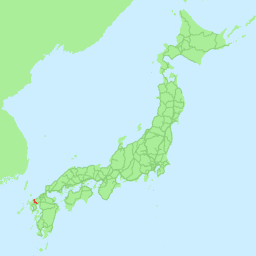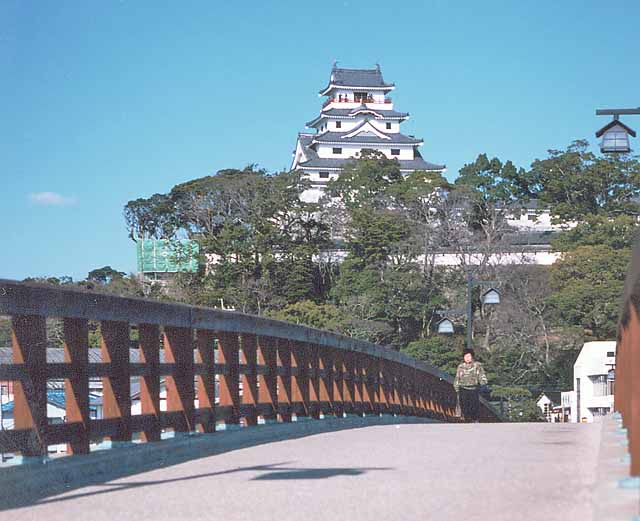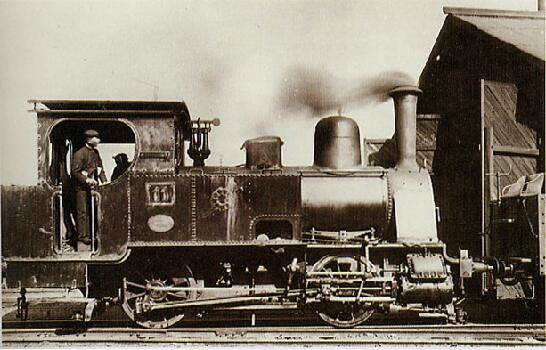|
Kyūragi Station
is a railway station on the Karatsu Line operated by JR Kyushu located in Karatsu, Saga Prefecture, Japan. Lines The station is served by the Karatsu Line and is located 20.8 km from the starting point of the line at . Station layout The station consists of two side platforms serving two tracks. Two sidings branch off the main tracks. The station building is of timber construction and is unstaffed, serving only as a waiting room. Access to the opposite side platform is by means of a footbridge. file:JRKyushu-Karatsu-line-Kyuragi-station-platform-20091101.jpg, A view of the platforms and tracks. the sidings can be seen behind the footbridge to the left. Adjacent stations History On 1 December 1898, the Karatsu Kogyo Railway had opened a track from Miyoken (now ) to . On 13 June 1899, the track was extended to Kyūragi which became the new eastern terminus. On 25 December 1899, Kyūragi became a through-station when the track was extended further east to ... [...More Info...] [...Related Items...] OR: [Wikipedia] [Google] [Baidu] |
JR Logo (kyushu)
JR, J. R. or Jr. may refer to: * Jr. or Junior (suffix), a name suffix Arts and entertainment * ''J.R.'' (album), an album by Jim Bob * ''J R'', a 1975 novel written by William Gaddis * "Jr.", a song by Codeine on the album ''Barely Real'' * J. R. Ewing, a television character from ''Dallas'' * JR Chandler, aka Adam Chandler Jr, a television character from ''All My Children'' * ''Jornal da Record'', a Brazilian news program on RecordTV Businesses and organizations * Aero California, defunct Mexican airline by IATA code * Japan Railways Group or the JR Group, the main operators of the Japanese railway network * Jember railway station * John Radcliffe Hospital * Joy Air, Chinese airline by IATA code People In arts and entertainment * JR (artist) (born 1983), French artist * J.R. (musician) (born 1979), American Christian musician and producer * JR (rapper) (born 1987), South African rapper and entrepreneur * ''J. R.'' a pen-name of writer John Ruskin * ''Jr.'', stage name of Par ... [...More Info...] [...Related Items...] OR: [Wikipedia] [Google] [Baidu] |
JR Kyushu
The , also referred to as , is one of the seven constituent companies of Japan Railways Group (JR Group). It operates intercity rail services within Kyushu, Japan and the JR Kyushu Jet Ferry Beetle hydrofoil service across the Tsushima Strait between Fukuoka and Busan, South Korea. It also operates hotels, restaurants, and drugstores across its service region. JR Kyushu's headquarters are in Hakata-ku, Fukuoka. ." Kyushu Railway Company. Retrieved on March 27, 2010. History When was divided in 1987, Kyushu Railway Company inherited its assets and operations on the island of |
Karatsu Line
The is a regional railway line in Saga Prefecture, Japan, owned and operated by Kyushu Railway Company (JR Kyushu). It connects in Saga City to in Karatsu City, both in Saga Prefecture, Japan. The line was originally constructed to carry coal from the Karatsu coal fields to the Port of Karatsu for export and had many branch lines to coal mines which have since closed. Operation All trains running on the Karatsu Line stop at all stations along the line, including through services from both sections of the Chikuhi Line. All trains that run to/from Kubota Station use the Nagasaki Main Line The , or simply Nagasaki Line, is a railway line owned by the Kyushu Railway Company (JR Kyushu) connecting Tosu Station in Saga Prefecture to Nagasaki Station in Nagasaki Prefecture, Japan. There is a separate branch of this line from Kikitsu S ... to terminate at Saga Station instead. Station list Station numbering has not been introduced for the Karatsu Line, but both and use the ... [...More Info...] [...Related Items...] OR: [Wikipedia] [Google] [Baidu] |
Train Station
A train station, railway station, railroad station or depot is a railway facility where trains stop to load or unload passengers, freight or both. It generally consists of at least one platform, one track and a station building providing such ancillary services as ticket sales, waiting rooms and baggage/freight service. If a station is on a single-track line, it often has a passing loop to facilitate traffic movements. Places at which passengers only occasionally board or leave a train, sometimes consisting of a short platform and a waiting shed but sometimes indicated by no more than a sign, are variously referred to as "stops", "flag stops", " halts", or "provisional stopping places". The stations themselves may be at ground level, underground or elevated. Connections may be available to intersecting rail lines or other transport modes such as buses, trams or other rapid transit systems. Terminology In British English, traditional terminology favours ''railway station' ... [...More Info...] [...Related Items...] OR: [Wikipedia] [Google] [Baidu] |
Karatsu, Saga
is a city located in Saga Prefecture on the island of Kyushu, Japan. Its name, formed from the Japanese word roots 唐 ''kara'' (China, or continental East Asia in general), and 津 ''tsu'' (port), signifies its historical importance as an ancient trading port between Japan with China and Korea. The central area of Karatsu, which does not include the former cities and villages of Higashimatsuura District, has a population of 78,386. As of January 1, 2020, the city had an estimated population of 117,663 and a population density of 241 persons per km2. The total area is 487.59 km2. On January 1, 2005, the towns of Chinzei, Hamatama, Hizen, Kyūragi, Ōchi, Yobuko and the village of Kitahata (all from Higashimatsuura District) were merged into Karatsu. On January 1, 2006, the village of Nanayama (from Higashimatsuura District) was merged into Karatsu. Geography Due to its proximity to mainland Asia, Karatsu has long been known as a stopover to Korea and China. ... [...More Info...] [...Related Items...] OR: [Wikipedia] [Google] [Baidu] |
Saga Prefecture
is a prefecture of Japan located on the island of Kyushu. Saga Prefecture has a population of 809,248 (1 August 2020) and has a geographic area of 2,440 km2 (942 sq mi). Saga Prefecture borders Fukuoka Prefecture to the northeast and Nagasaki Prefecture to the southwest. Saga is the capital and largest city of Saga Prefecture, with other major cities including Karatsu, Tosu, and Imari. Saga Prefecture is located in the northwest of Kyūshū covering an isthmus-like area extending between the Sea of Japan and the Ariake Sea. Saga Prefecture's western region is known for the production of ceramics and porcelain, particularly in the towns of Karatsu, Imari, and Arita. History In ancient times, the area composed by Nagasaki Prefecture and Saga Prefecture was called Hizen Province. The current name dates from the Meiji Restoration. Rice farming culture has prospered here since ancient times, and vestiges can be seen at the ruins of Nabatake in Karatsu and the Yoshinogari sit ... [...More Info...] [...Related Items...] OR: [Wikipedia] [Google] [Baidu] |
Kyushu Railway
was a company that built and operated railways in Kyushu, one of four main islands of Japan. Most of its lines came under the control of Japanese Government Railways following nationalization in 1907, and many are now operated by Kyushu Railway Company. History The company was incorporated on August 15, 1888 in Fukuoka, Fukuoka. The first of the railway, between Hakata Station in Fukuoka and Chitosegawa temporary station in Asahi, Saga (near Kurume, Fukuoka), opened on December 11, 1889 as the first railway in Kyushu. The company expanded the railway by means of both construction and acquisition of other companies. As of 1907, it operated of railways in Fukuoka, Kumamoto, Nagasaki, Ōita and Saga prefectures in northern Kyushu. On July 1, 1907, the entire operation of the company was purchased by the government of Japan under the Railway Nationalization Act. Consequently, the company was dissolved. List of lines Rolling stock A special coach made by German car manufacture ... [...More Info...] [...Related Items...] OR: [Wikipedia] [Google] [Baidu] |
Japanese Government Railways
The Japanese Government Railways (JGR) was the national railway system directly operated by the Japanese Ministry of Railways ( ja, 鉄道省, Tetsudō-shō, ) until 1949. It was a predecessor of Japanese National Railways and the later Japan Railways Group. Name The English name "Japanese Government Railways" was what the Ministry of Railways (established in 1920) used to call its own and sometimes the ministry itself as a railway operator. Other English names for the government railways include Imperial Japanese Government Railways and Imperial Government Railways, which were mainly used prior to the establishment of the ministry. This article covers the railways operated by the central government of Japan from 1872 to 1949 notwithstanding the official English name of the system of each era. Network By the end of World War II in 1945, the Japanese Government Railways operated on the main Japanese islands of Honshū, Hokkaidō, Kyūshū, Shikoku and Karafuto. The railways ... [...More Info...] [...Related Items...] OR: [Wikipedia] [Google] [Baidu] |
Japanese National Railways
The abbreviated JNR or , was the business entity that operated Japan's national railway network from 1949 to 1987. Network Railways As of June 1, 1949, the date of establishment of JNR, it operated of narrow gauge () railways in all 46 prefectures of Japan. This figure expanded to in 1981 (excluding Shinkansen), but later reduced to as of March 31, 1987, the last day of JNR. JNR operated both passenger and freight services. Shinkansen Shinkansen, the world's first high-speed railway was debuted by JNR in 1964. By the end of JNR in 1987, four lines were constructed: ; Tōkaidō Shinkansen: , completed in 1964 ; Sanyō Shinkansen: , completed in 1975 ; Tōhoku Shinkansen: , as of 1987 ; Jōetsu Shinkansen: , completed in 1982 Buses JNR operated bus lines as feeders, supplements or substitutions of railways. Unlike railway operation, JNR Bus was not superior to other local bus operators. The JR Bus companies are the successors of the bus operation of JNR. Ships JNR o ... [...More Info...] [...Related Items...] OR: [Wikipedia] [Google] [Baidu] |
Route 203 (Japan)
National Route 203 is a national highway of Japan connecting Karatsu, Saga and Saga, Saga is the capital city of Saga Prefecture, located on the island of Kyushu, Japan. Saga was the capital of Saga Domain in the Edo period, and the largest city of former Hizen Province. As of August 1, 2020, the city had an estimated population of ... in Japan, with a total length of 47.3 km (29.39 mi). References National highways in Japan Roads in Saga Prefecture {{Japan-road-stub ... [...More Info...] [...Related Items...] OR: [Wikipedia] [Google] [Baidu] |
Railway Stations In Saga Prefecture
Rail transport (also known as train transport) is a means of transport that transfers passengers and goods on wheeled vehicles running on rails, which are incorporated in tracks. In contrast to road transport, where the vehicles run on a prepared flat surface, rail vehicles ( rolling stock) are directionally guided by the tracks on which they run. Tracks usually consist of steel rails, installed on sleepers (ties) set in ballast, on which the rolling stock, usually fitted with metal wheels, moves. Other variations are also possible, such as "slab track", in which the rails are fastened to a concrete foundation resting on a prepared subsurface. Rolling stock in a rail transport system generally encounters lower frictional resistance than rubber-tyred road vehicles, so passenger and freight cars (carriages and wagons) can be coupled into longer trains. The operation is carried out by a railway company, providing transport between train stations or freight customer faci ... [...More Info...] [...Related Items...] OR: [Wikipedia] [Google] [Baidu] |
Stations Of Kyushu Railway Company
Station may refer to: Agriculture * Station (Australian agriculture), a large Australian landholding used for livestock production * Station (New Zealand agriculture), a large New Zealand farm used for grazing by sheep and cattle ** Cattle station, a cattle-rearing station in Australia or New Zealand **Sheep station, a sheep-rearing station in Australia or New Zealand Communications * Radio communication station, a radio frequency communication station of any kind, including audio, TV, and non-broadcast uses ** Radio broadcasting station, an audio station intended for reception by the general public ** Amateur radio station, a station operating on frequencies allocated for ham or other non-commercial use ** Broadcast relay station ** Ground station (or Earth station), a terrestrial radio station for extraplanetary telecommunication with satellites or spacecraft ** Television station * Courier station, a relay station in a courier system ** Station of the ''cursus publicus'', a sta ... [...More Info...] [...Related Items...] OR: [Wikipedia] [Google] [Baidu] |


.jpg)




